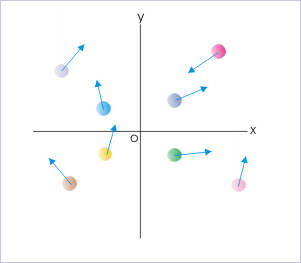| << Chapter < Page | Chapter >> Page > |
An aggregate of objects may have combination of motions. Some of the subjects may be translating, others rotating and remaining may be undergoing a mix of motions. Conservation of angular momentum encompasses to analyze such complexities in motion. The generality of the conservation law is actually the reason why angular momentum has been defined about a point against an axis. This provides flexibility to combine all motion types. Had the angular quantities been defined only about an axis, then it would not have been possible to associate different types of motions with angular momentum. For example, it would have been difficult to apply law of conservation of angular momentum for randomly moving particles as shown in the figure below.
System of particles

Conservation of angular momentum, like conservation of linear momentum and energy, is fundamental to the nature and laws governing it. It is more fundamental than classical laws as it holds where Newton's law breaks down. It holds at sub-atomic level and also in the realm of motion, when it nears the speed of light.
We have studied that the time rate of change of angular momentum of a system of particles is equal to net external torque on the system. This is what is known as Newton's second law in angular form for a system of particles. It, then, follows that the angular momentum of the system will be conserved, if net external torque on the system is zero. Though, there is no external torque on the system, the particles inside the system may still be subjected to forces (torques) and, therefore, may undergo multiple change in velocity (angular velocity). Evidently, we can analyze resulting motions of the system with the help of the conservation of angular momentum.
There are many ways or forms in which this law can be stated. Mathematically,
From these result, we can state conservation of angular momentum in following equivalent ways :
Application of conservation of angular momentum is required to be made under the circumstance of zero torque. This condition, however, does not imply that net force on the system is zero. The two conditions are different. There may be net external force on the system, but the torque on it may be zero. This is the case, when net external force acts through center of mass of the system of particles or the rigid body or their combination.
Application of the law of conservation of angular momentum is not as straight forward as it may appear. Theoretically, though, it is possible to conceive or define a system such that there is no external torque, but in real time situation it is not advisable to adjust the system to reduce net external torque to zero. If we also consider the fact that we have to consider angular momentums of all objects within the system about certain points and/or axes, then we realize that it is not actually possible to apply this law in most of the real time situation - unless when we have some complex algorithm with a powerful computer at our disposal.

Notification Switch
Would you like to follow the 'Physics for k-12' conversation and receive update notifications?